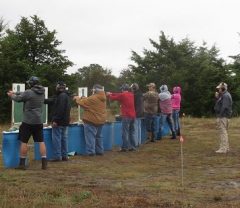There are now over 1,000,000 Texans licensed to carry a handgun in public. As to how many of them actually do, no one knows. Some carry every day, every place that is legal; some carry only on rare occasion; and some carry only in a vehicle, and use the license to prove to police that they have demonstrated the required firearm proficiency.
Whether or not one carries regularly, there is never-ending debate on the subject of carry condition: round in the chamber or not; cocked or not; safety on or not. Those experienced in carrying a gun debate these points mostly for fun, but for those new to carrying a gun, this raises some serious questions.
First, let us set some context. Some guns are hammer-fired (all 1911s, most revolvers, and some other guns), and some are striker-fired (probably most easily-concealable guns). While it is true that some guns use an internal (shrouded) hammer that is not the same as a striker, that is a distinction without a difference in this discussion; the real question is whether or not a gun can be cocked with your thumb. Any gun when cocked is in single-action mode (fireable with minimal effort). If it has an external hammer, it can be decocked (uncocked), either through a decocker lever, or manually (safety hazard). If the gun is a double-action model (DA/SA), it can still be fired immediately while decocked (with more effort), but if it is a single-action model (SA), it cannot. Never decock an SA gun, as it is then useless. Many of these models are difficult and dangerous to cock manually. Except for the hammerless models designed for concealed carry, all revolvers are DA/SA, and without a safety, so these should never be carried (or left anywhere) cocked.
To complicate this discussion more, there is the empty chamber issue (this applies only to semi-autos). While it is true that in many cases, one would have time to rack the slide (hearing reports of an active shooter nearby, for example), in some cases one would not (walking into a robbery in progress, or being car-jacked). In my view, it is a mistake to carry without a round in the chamber.
Since putting a round in the chamber necessarily means the action is cocked, one must then consider whether the gun has a safety at all, and if so, whether to use it. Besides internal safeties over which you have no control, and grip safeties which are automatic (1911s), you basically have two types of safeties extant on some pistols: trigger safeties and thumb safeties. Trigger safeties are really marketing gadgets, and are unlikely to prevent most accidental discharges. All hammer-fired guns will have a thumb safety, and it is mandatory that you use it. Striker-fired guns may have a thumb safety, but usually don’t. If it does not, then carry it as it is; the triggers are usually not so light in pull that this is overly dangerous. If it has a thumb safety, then use it only if you can take it off easily during presentation, otherwise leave it off.
The bottom line is that you need to be prepared to draw your gun from the holster and get to the High Ready position, with a sight picture, and the gun in immediately dischargeable condition, in about 3 seconds. If that requires taking off the safety during presentation, then practice that way, and always carry the gun in the same condition. Pulling the trigger, finding out the action is locked, taking off the safety, and pulling again, could take the rest of your life.
